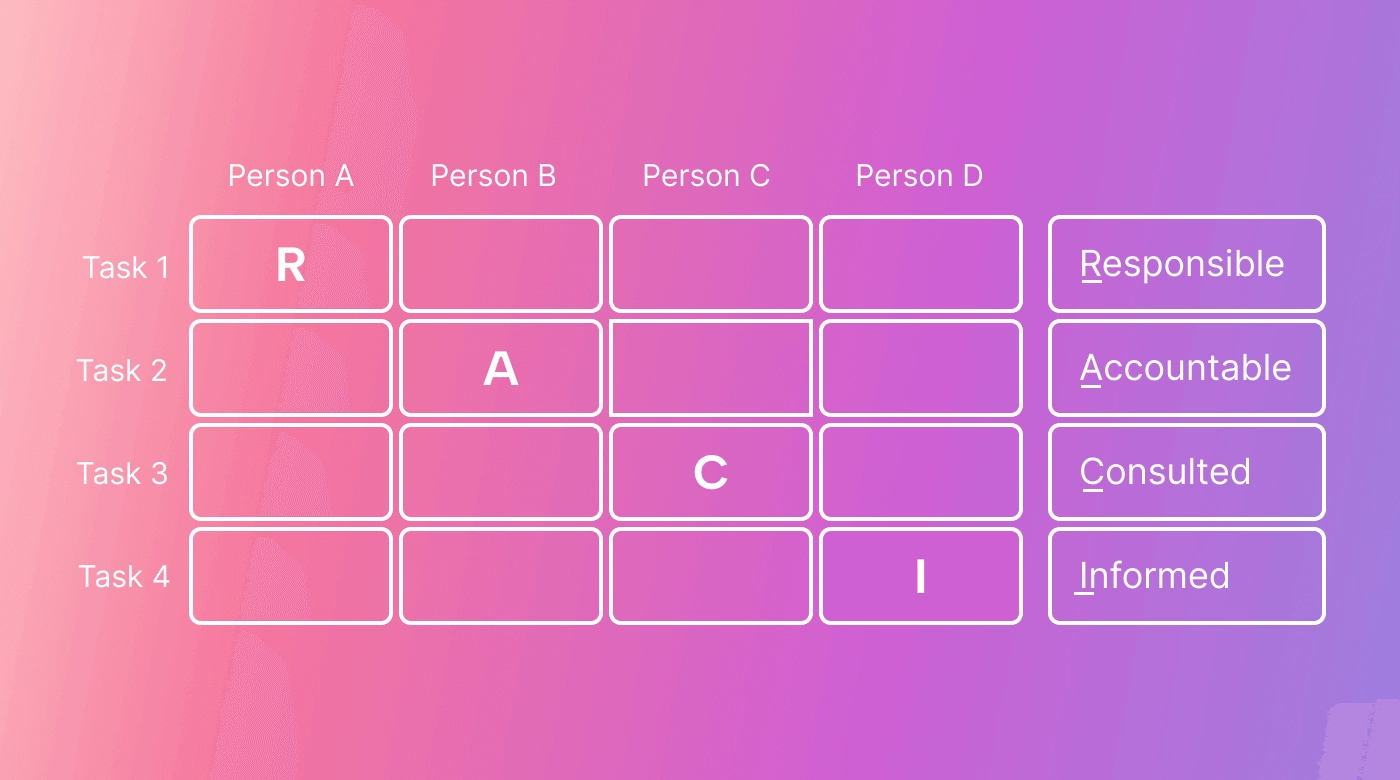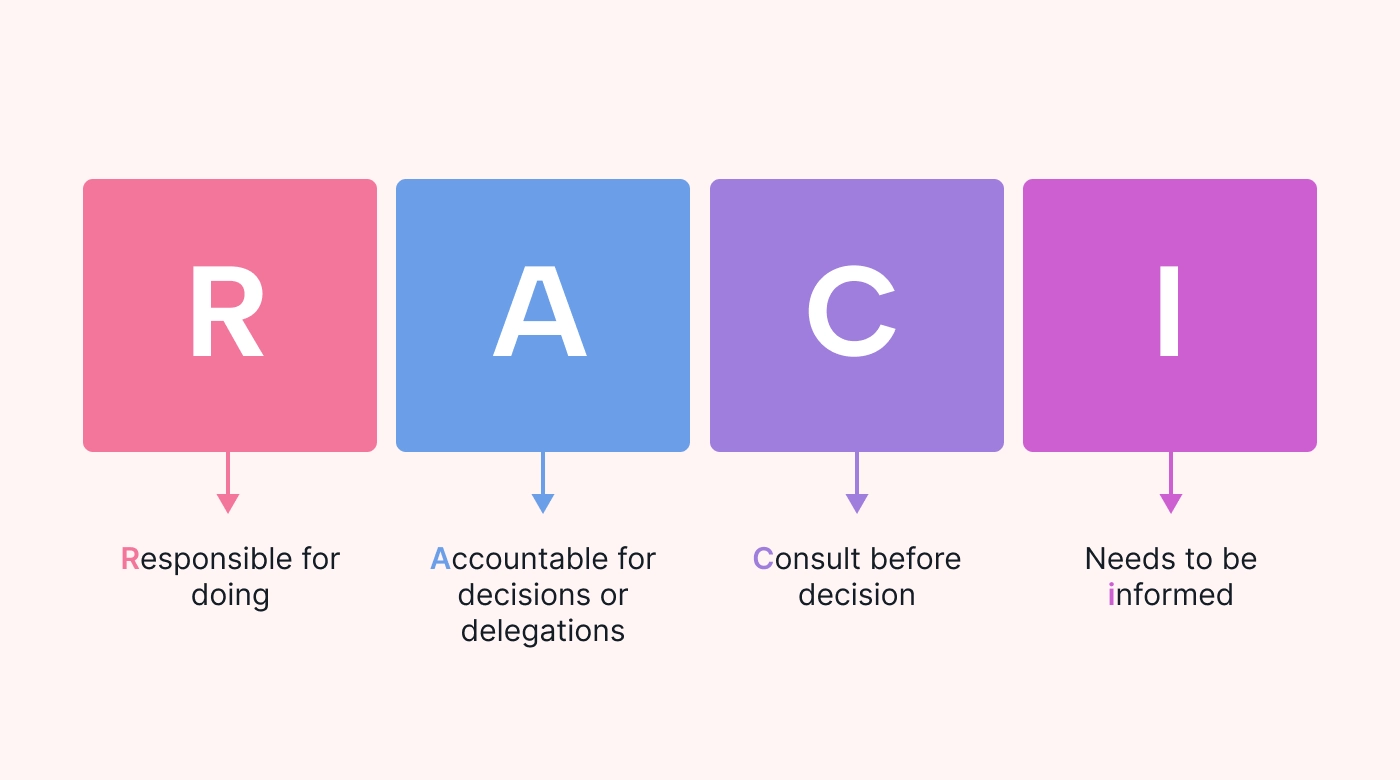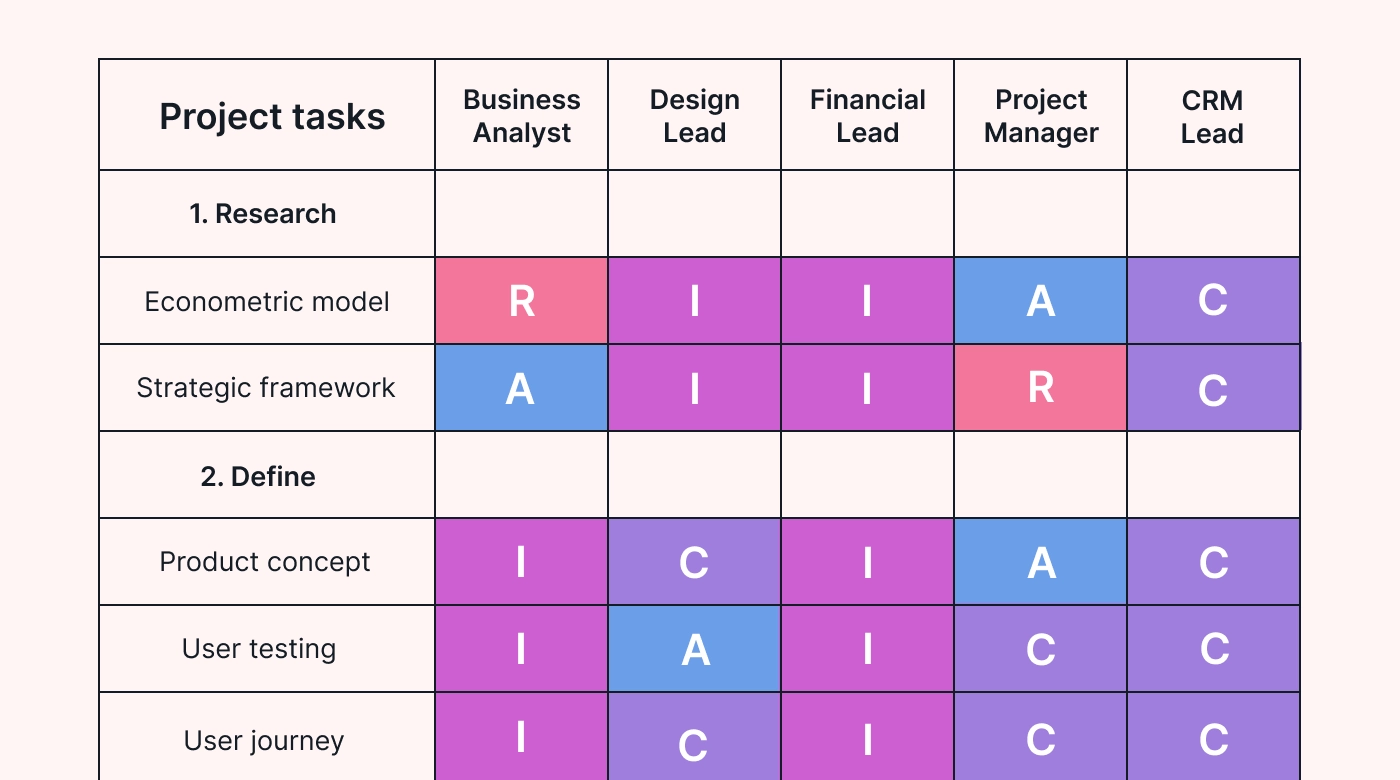Every project should begin with a strategic project plan. You need to be able to articulate your goals, specify deliverables, and break them down into bite-sized project tasks.
But even this level of detail isn’t enough if everyone’s roles and deadlines aren’t crystal clear.
This is where project teams might use the RACI responsibility assignment matrix to simplify accountability, but is it all it’s cracked up to be? What are the common pitfalls of the RACI model for large-scale projects?
In this guide, we'll uncover:
- The essence of the RACI chart in project management
- The guiding principles that govern RACI
- The four key roles that underpin RACI charts
- The perfect scenarios to unleash the power of a RACI matrix
- The pros and cons of the RACO model
Plus, you won't want to miss our three pro tips to make assigning accountability easy.
What is the RACI matrix, and why should you care?
In larger projects, given all the work (tasks), there can be a high potential for confusion on who does what. That's where RACI charts come in.
The RACI matrix is a tool in project management that's designed to clarify accountability and responsibility for the work to be done.
It's like a roadmap for everyone (including key stakeholders), showing exactly who's doing what, who needs to be looped in, and where the proverbial buck stops. It stops the chaos and helps you keep your project on track.
The RACI is a tool for project managers (much like a cheat sheet) to keep things organized and everyone on the same page.
What are the four roles of RACI?
RACI stands for Responsible, Accountable, Consulted, and Informed — four project roles that give each team member a clear job in the decision-making and project execution.
Here's what they do:
Responsible (R): The responsible individual(s) are the ones doing the hands-on work. There can be more than one responsible person per task.
Accountable (A): The accountable party gets all the credit (or blame) for how things turn out. This should only be a single person.
Consulted (C): These are the advisors who should be consulted before decisions are made.
Informed (I): The informed party (or people), even if not in the thick of it, need to know what's happening, like external stakeholders, clients, the executive team, or you, as the business owner.
By highlighting these roles, you'll build transparency into the project that makes it easy for your project team to understand the hierarchy while taking some pressure off you as the main decision-maker.
How do you create a RACI matrix?
A matrix template is simple to set up and use with these four easy steps:
1. Identify tasks
List all tasks or activities related to the project. Don’t get too into the details of the tasks, but make sure every task is noted.
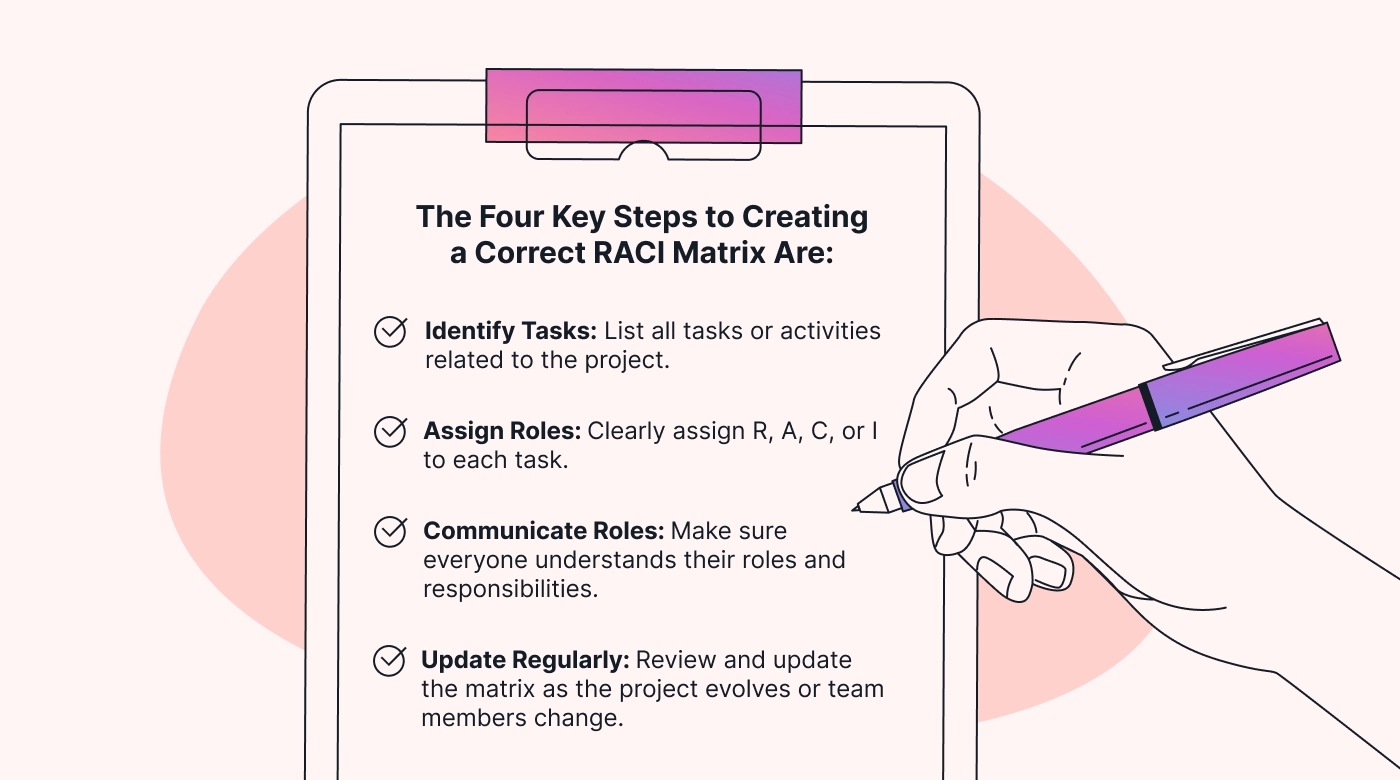 |
2. Assign roles
In the left column, list every task. In the top row, list everyone involved with the project.Then assign R, A, C, or I to each task in the column of the person it applies to.
For example, suppose you were developing a marketing plan. In that case, the person responsible for market research may be in the ‘R’ role, while the marketing manager may be the person accountable for the results (‘A’). Other departments, like sales and the product team, might be consulted for the best selling points to include in the marketing campaign (‘C’), and executive leadership may be informed (‘I’) about the targets the campaign seeks to achieve.
Here’s an example of a product team’s RACI matrix.
3. Communicate roles
Once you’ve created the matrix, share it with your team and ensure everyone understands their roles and responsibilities.
4. Update regularly
Then, review and update the matrix regularly as the project evolves or team members change so it remains a true representation of responsibilities in your team.
What are the benefits of the RACI matrix?
There are quite a few reasons why you might want to try out a RACI matrix for your project team, including:
Clarity and role definition
By clearly defining who’s Responsible, Accountable, Consulted, and Informed for each task, team members have no doubt what their role is in the project.
This clarity reduces confusion and helps make sure that no one is duplicating work or forgetting about tasks. Everyone can move forward and be confident they are working on the right thing at the right time.
Accountability
One of the primary benefits of a RACI matrix is how visible it makes accountability. The matrix defines an "Accountable" person for each task who's ultimately answerable for its success.
Improves communication
The RACI matrix ensures that anyone who needs to be kept informed stays in the loop (and their role).
Team members know when their input is required, preventing delays and bottlenecks in the project workflow.
Optimized resources and workflow
With clearly defined roles, team members can focus on their specific responsibilities. By defining who needs to be consulted (C) or informed (I), unnecessary meetings and communication overhead are minimized. This helps with more efficient use of everyone's time.
Simplified decision-making
The RACI matrix serves as a reference point for resolving disputes or addressing challenges within the project. If there is confusion or disagreement about roles, team members can easily refer to the matrix to clarify responsibilities.
Plus, the matrix can guide decision-making because it highlights the individuals that need to be involved. This will help keep project momentum and ensure that decisions align with the overall project and business goals.
The RACI matrix provides a structured framework for what can sometimes be unspoken in a project, eliminates confusion (even micromanagement), and leads to better project outcomes.
What are the problems or challenges of the RACI matrix?
With that said, there are also some limitations to the RACI matrix:
Ambiguity in role definitions
The RACI relies on a very clear definition of roles. Not good for those "grey" areas, and (as we all know) ambiguity can pop up when things aren't clear.
It's critical to make sure your team understands the distinction between responsibility and accountability so that the work gets done by the right people at the right time.
Overemphasis on hierarchy
The matrix can sometimes reinforce hierarchical structures that might not work for your team.
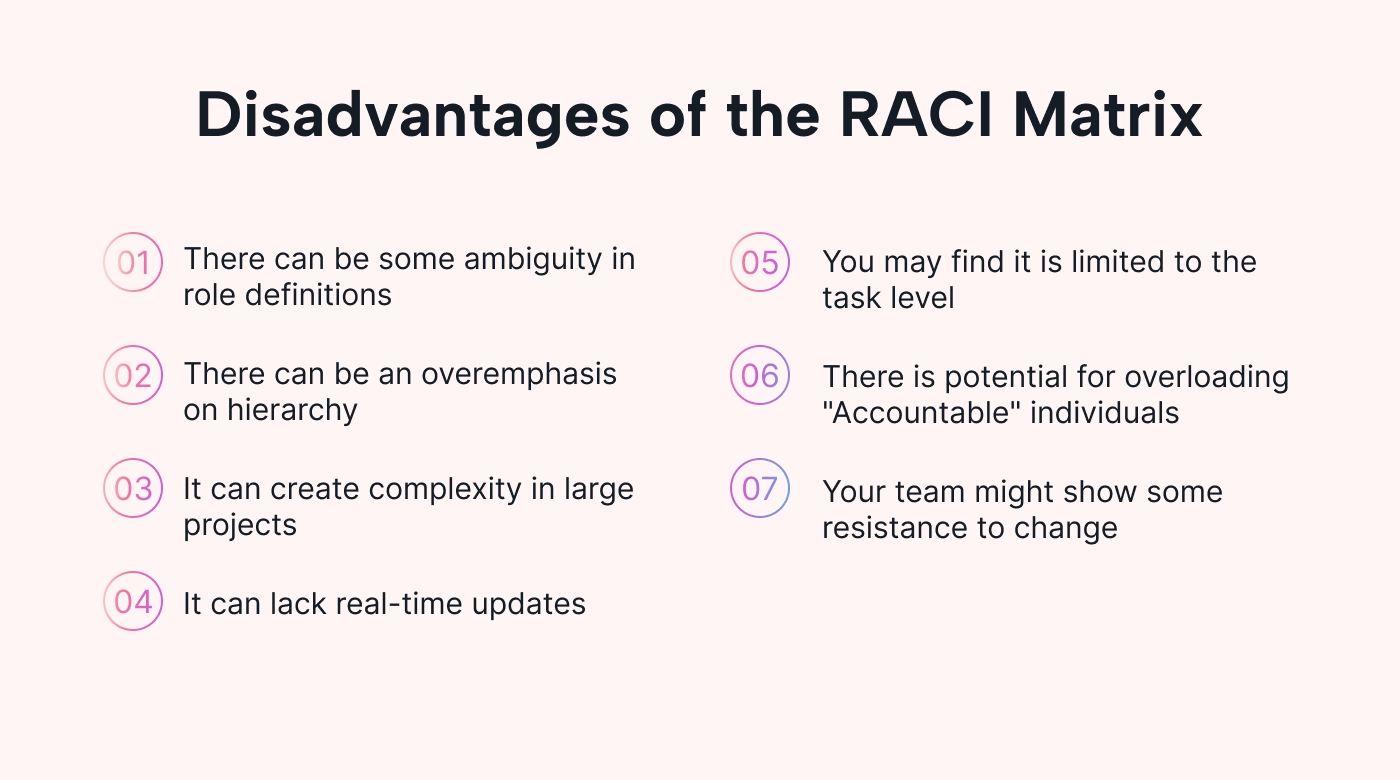 |
This can lead to a lack of flexibility and get in the way of collaboration, especially in more dynamic or cross-functional team environments where things need to happen quickly.
Complexity in large projects
The RACI matrix can become unwieldy and challenging to manage in large, complex projects.
Without real-time updates, the matrix may quickly become outdated. This adds to project stress and creates confusion (the opposite of what we want it to do).
Lack of real-time updates
The static nature of a RACI matrix can be a drawback when tasks or teams change often.
Without real-time updates, the matrix may quickly become outdated. This adds to project stress and creates confusion (the opposite of what we want it to do).
The key here is to keep it updated so it's a real-time reflection of the project.
Limited to task level
The RACI matrix is at the task level (which doesn't capture the broader aspects of how your team works together and communicates).
The matrix can help you visualize roles, but if the dynamic doesn't work for the team, the matrix will be another tool that's ignored.
Resistance to change
Like any new tool or process, a RACI matrix can face resistance, especially if your team is used to more flexible or informal collaboration structures.
If you address them with your team and allow them to give you feedback, you can still make the RACI matrix useful as part of a wider project management toolbox.
So, when shouldn’t you use the RACI matrix (and what can you use instead)?
While the RACI matrix is a valuable tool for many projects, there are situations where it may not be appropriate or effective.
For straightforward and small projects with a limited number of tasks and team members, the time investment of creating and maintaining a RACI matrix might outweigh its benefits. If that’s the case, it may be better to keep communication more casual.
A static RACI matrix will become quickly outdated in highly dynamic or agile environments where tasks and roles often change. The time investment to keep it up to date is probably better spent elsewhere.
Projects that need a lot of creativity, collaboration, and shared decision-making won’t do well with so much structure. In these situations, open communication and brainstorming may be more appropriate.
In projects where tasks are highly interdependent and require constant communication and collaboration, the RACI matrix might not capture the fluid nature of these interactions. Over-reliance on the matrix could hinder adaptability.
Before deciding whether to use the RACI matrix, consider the project’s specific characteristics, your team, and your organizational culture. Alternative project management tools and approaches might be a better fit, and that’s fine.
What can you use instead of RACI?
RACI is just one variant of the Responsibility Assignment Matrix (RAM). There are others that you could try:
 |
- PACSI, an acronym for Perform, Accountable, Control, Suggest, Inform, introduces a quality control partner in the Perform role. In contrast, the Suggest role signifies individuals with task-specific expertise but lacking final decision authority.
- CARS, denoting Communicate, Approve, Responsible, Support, emphasizes the importance of support from other team members for the person(s) responsible for a task.
- RASCI, an extension of RACI, introduces the letter 'S' for Support or Supportive. In this model, Supportive individuals help the Responsible party.
- DACI, representing Driver, Approver, Contributor, and Informed, mirrors the RACI model in delineating roles related to task execution, approval, advisory contributions, and information reception.
- RAPID, an alternative decision-making model, stands for Recommend, Agree, Perform, Input, Decide. This model outlines distinct steps in the decision-making process, offering a comprehensive approach beyond the traditional RACI structure.
- CLAM, a parallel to RACI, stands for Contribute, Lead, Approve, Monitor, providing a unique perspective on task-related roles.
- RAS simplifies the CARS model to Responsible, Approve, Support, omitting the communication aspect addressed separately.
Whichever you decide to try will come with its own unique challenges, so be sure to experiment until you find the right one for you and your team.
3 pro tips to make your RACI work for your business
If you're ready to run with the RACI, though, here are three pro tips to get you started.
1. Focus on effective communication across the board
- Yes, a model like RACI can help with accountability in one project. Still, it’s important to look at how your project team communicated across your entire workflow regardless of the project.
- RACI is not a fix-all for how your team works together or communicates.
- Instead, investigate improvements to your project management overall.
2. Clearly define your definitions so there’s no guesswork
- Whether you run with the RACI, DACI, or one of the other Responsibility Assignment Matrices (RAM), ensure there's no ambiguity in what each role means.
- Review how well roles worked and whether they were assigned to the correct people.
- Then, optimize how your matrix is applied over time.
3. Let AI help you manage accountability
- RACI will help you define your accountabilities, but a project management tool like Motion can help you with much more.
- AI-driven project management assistants can create optimal schedules for your entire team, with the highest-priority tasks scheduled first.
- And when it's time to meet, AI-driven project management software can be a helpful tool to find optimal times to do so.
Motion is your partner in assigning accountability
The RACI matrix is an effective tool for establishing roles and accountability in your projects, but it's not a fix-all solution. Sometimes, roles can get a bit fuzzy, and frustration can arise if one person's juggling too much. That's where alternatives like PACSI, CARS, and DACI can offer a fresh take.
Whichever model you try, let Motion handle your task assignment.
Auto-task assignment? Check.
Create an optimized schedule for your project team in real-time. Check. Check.
Motion isn't just a tool. It's your partner in project management.

Haylee is a versatile writer with ten years of experience. With a background in marketing and writing for large SaaS companies, Haylee brings her passion for the written word to diverse projects ranging from blog posts and ebooks to direct marketing campaigns.

